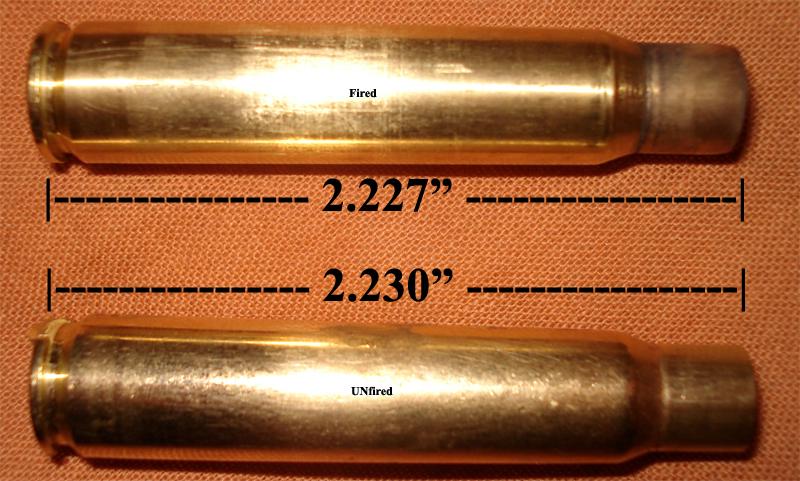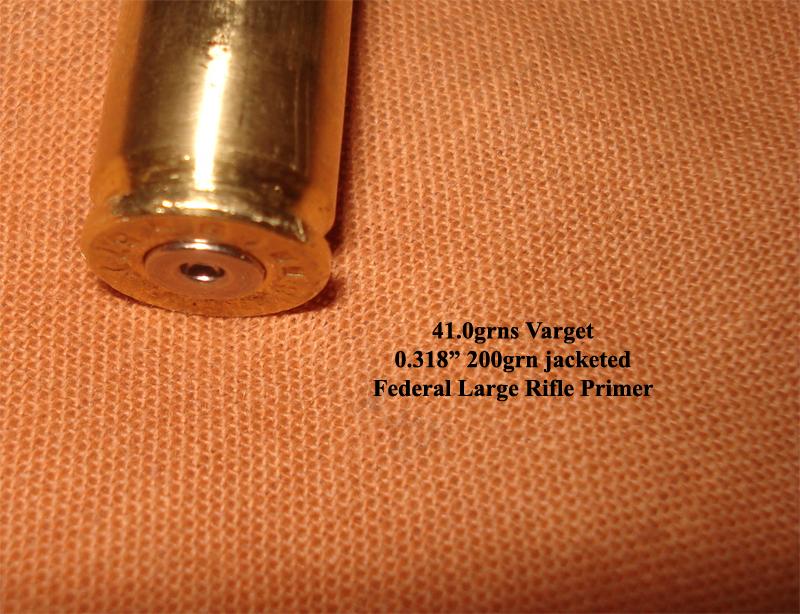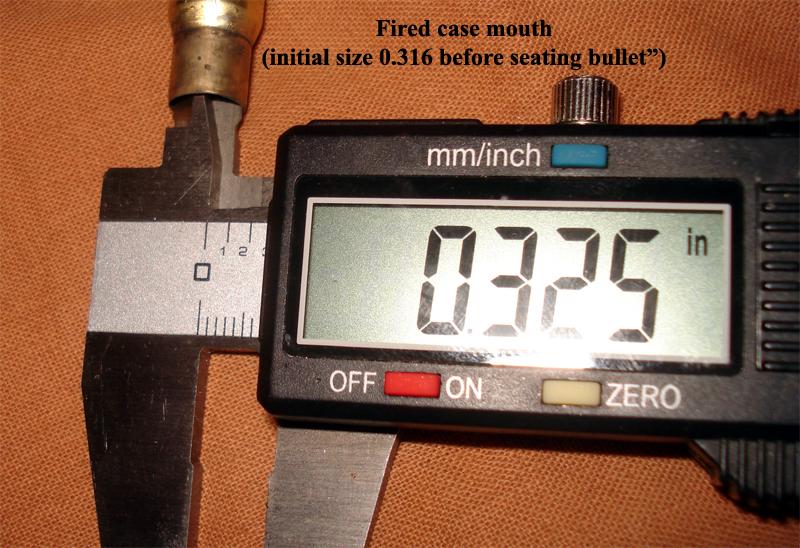-
FREE MEMBER
NO Posting or PM's Allowed

Gew 88/05 "S" Marked Barrel Specifics?
Hello,
I'm quite confused on this one.
My "S" marked Commission Rifle Gew88 slugs to 0.310" x 0.3165". However, the barrel seems to have a taper.
I have read and have been told that the whole barrel was opened up for the 0.323" bullet, if it was modified. My measurements don't bear that out.
I have read, and been told, that the chamber and leade were the only things opened up so as not to cause overpressure, but that the barrel diameter was kept the same.
Then I've been told several other things.
I know that it shoots well with a 0.318" 200grn jacketed bullet, about an inch at 50 yards.
However, I have primer setback at the minimum charge of Varget, and that seems to indicate low pressure (headspace is OK according to an old gauge, but I've ordered a new field gauge just to be sure).
A too-small bullet diameter would cause low pressure.
The barrel is not stepped, but rather tapered, and is German . It went to Turkey
. It went to Turkey for WWII and I'm given to understand they used 0.323 ammo.
for WWII and I'm given to understand they used 0.323 ammo.
Any help clearing up this confusion would be very much appreciated!
Thanks,
Josh
Information
 |
Warning: This is a relatively older thread
This discussion is older than 360 days. Some information contained in it may no longer be current. |
|
-
08-27-2011 12:44 PM
# ADS
Friends and Sponsors

-
A minimum charge almost always backs out primers for me. I thinkall you need to do is step up the charge weight and the primer drama will go away. Accuracy doesn't look too bad at pistol distance, so stretch it out a bit!
You are correct as regards the bore. Lots of conflicting info out there! As you have measured, the bore is original, just the lead is longer. Which doesn't help accuracy, but doesn't destroy it for military purposes..
-
-
-
Advisory Panel



Originally Posted by
jmoore

just the lead is longer.
... which is why these rifles will perform better with the long 200 gn bullets than with lighter weights. And flat-base will be better than boat-tail. Both the factors help to get the bullet down the lead as far as possible before the back end of the bullet leaves the neck of the case. Yes, I know that the case will expand before the bullet gets moving, but a cylindrical back end in the expanded neck is still a lot better centered than a boattail flapping about in that long lead with hot gases washing all around it.
Patrick

-
Thank You to Patrick Chadwick For This Useful Post:
-
FREE MEMBER
NO Posting or PM's Allowed

-
Advisory Panel


Clarification (I hope) of the 8x57I /8x57IS confusion
As several queries have involved this matter, here is the real story.
1) With the Gew.88, the Germans introduced the 8x57I cartridge, the I standing for Infantry. In German literature you may find 8x57J. Don't worry, it's the same thing, but the Germans often used a capital J instead of I in print, to avoid confusion with the number 1.
literature you may find 8x57J. Don't worry, it's the same thing, but the Germans often used a capital J instead of I in print, to avoid confusion with the number 1.
2) It was discovered that the bullet was too small for the bore. Gas blowby led to rapid barrel wear.
3) The military therefore increased the bullet diameter when they introduced the Spitzer bullet (hence the S). This was a better fit in the bore, and resulted in both improved barrel life and improved accuracy. Note that the bullet was changed, to suit the barrel - not the other way around. The land/groove dimensions were not altered. But the neck end of the chamber + lead had to be reamed out to accept the larger bullet.
All military rifles thus altered were marked with an S (for Spitzer) and the chambering/cartridge was renamed to 8x57IS (or 8x67JS). As the offical date of this change was 1905, the Gew.88 rifles thus marked are known as Gew.88/05.
4) While the military was painfully facing up to the need for change, civilian gunmakers had long implemented their own solution - which was to change the barrel to suit the bullet!
So the bore dimensions (land/groove diameters) were reduced, enabling civilians to continue using the original bullets and cases (which must have been cheaply available by the million when the 8x57I was phased out by the military). It took nearly forty years until this chambering was officially recognized and standardized as 8x57I in 1939.
When wondering what ammo is right for your 8x57 is it therefore vital to distinguish between military and civilian rifles.
Military
Gew.88 with the S mark (i.e. Gew. 88/05)
- this has the standard 8x57IS chambering. No problem with cartridge dimensions. But please remember (as always) that the words "full load" and "century-old rifle" do not go well together.
If you came across some 8x57I ammo and fired it in these rifles - no problem, but probably poor performance (and throat erosion).
Gew.88 without the S
If you find one of these, do NOT try and feed it with 8x57IS ammo. If the cartridge can be chambered at all, the cartridge neck will be a jam fit in the chamber, and will therefore produce serious overpressure when fired. In this case, you must use 8x57I ammo.
Civilian
The civilian picture is totally unsure. The late introduction of the standarization distinction between 8x57I and 8x57IS, plus the fact that there are plenty of civilian rifles around that have been converted from military rifles, means that the ONLY safe thing to do with a civilian 8x57 is to measure the chamber before firing anything! (It's always a good idea for any rifle, regardless of what may be stamped on it!)
Patrick

Last edited by Patrick Chadwick; 08-27-2011 at 05:33 PM.
-
The Following 4 Members Say Thank You to Patrick Chadwick For This Useful Post:
-
Advisory Panel



Originally Posted by
Josh Smith

that the neck opens up as much as it does.
Seems huge, but the minimum chamber diameter at the neck (CIP data) for the 8x57IS is 9.1 mm = 0.358"
Use neck-sizing for the reloads, and the accuracy should improve.
Patrick

Last edited by Patrick Chadwick; 08-27-2011 at 03:23 PM.
-
-
Advisory Panel


Slugging the bore

Originally Posted by
Josh Smith

0.310" x 0.3165".
That worries me. Those figures sound more like a worn 8x57I than a 8x57IS. Right from the start, the bore (groove) diameter for the 8x57 was 8.2 mm = 0.323".
Please check your measurements. If you simply drive a slug through the bore, it may not fill the grooves completely. You need to bang it from both ends while it is in the bore, to make sure that it realls slugs up to fill the grooves.
Stand the rifle on end on a piece of hard wood with a piece of 1/4" brass rod in the muzzle. then drive down the slug from the chamber end with another rod until it reaches the first rod. A couple of taps, by dropping the upper rod onto the slug, will upset it between the two rods so that it really fills the grooves. Then remove the lower rod and drive the slug through and out of the muzzle. You may find you get a larger groove measurement this way.
Patrick

-
-

Originally Posted by
Josh Smith

I'm finding it fascinating that the cases actually seem to shrink compared to unfired but sized cases, and that the neck opens up as much as it does....
Thinking about it further, I've not had any brass cut using the Lee sizer. I figured it was just the mild loads... but could the brass actually be shrinking lengthwise while fattening up around the case mouth and maybe the middle? Thanks, J.S.
Your supposition is correct, but only for the first firing, unless you size it all the way back each time. THe primer set back at low pressure is due to the nature of the firing sequence, and the primer hole restriction. When the primer explodes, it is a high pressure event, which leaks out the primer hole to the main charge which burns in a controlled manner (rather than exploding). Since the primer lights off first, the pressure is high in that little area, and since the bolt stops the primer cup from moving backwards, the pressure will push the case forward as far as possible, sometimes even pushing the shoulder back a little. If the chamber pressure is low, it won't be able to reseat the primer cup and plastically deform the case to fill the chamber completely.
I've often wondered if enlarging the primer hole to equalize pressures in the primer cup area and the powder containing area more quickly would reduce the case set back in reduced pressure rounds. Some have claimed it to be the case, but I haven't verified it.
-
-
FREE MEMBER
NO Posting or PM's Allowed

Hello,
Thank you for the information.
When slugging the Mosin, nobody has ever mentioned squashing it, but I did come out with with 0.001" less on the bore than I would have expected from a 91/30. Maybe this is the same thing?
Regardless, it is stamped "S" and has likely seen 0.323" bullets most of its life. Would you tend to agree?
The only reason I've not fired 0.323" bullets in it as of yet is that some have told me that it's bad, even with the "S". This makes no sense, but I didn't want to split the barrel.
I'm sure the throat is relieved. I do something with these old rifles that I don't see recommended by anyone, but it works for me: I use a primer to pop the bullet into the leade. This gives me an accurate measure of what's going on in there.
A 0.318" bullet comes away with very light rifling marks only, and not touched otherwise. I can only see, not feel, the rifling marks.
The barrel is original.
All signs point to it being a 0.323" chamber and leade. I think I'll order a few 0.323" bullets and start it with a light load, see what happens. S marked, it shouldn't hurt it.
I'll let you all know.
Thanks,
Josh
-
I've had '88s with both bore sizes, but no differences in markings. "S" on both. I can't remember the last time one turned up without the "S", and haven't measured such a beastie. Not a major ID of 0.316", but 0.318" or 0.319". (I think I sold the last "small bored" one a while back, but I'm not sure!) As a four groover, you can just use calipers at the muzzle if it's not worn and you have a good "touch". Try a few known bore diameters first to see what readings you get, though.
BTW, if you've ever had to indicate a bore to get good concentricity on a lathe, you will not be surprised after a while to find that grooves aren't all the same depth, nor concentric to the lands in some cases. Usually no more than 0.001" or a few "tenths" (0.0001") more, but it's normal. What will make you scratch your head is when you note it on button rifled barrels!
ETA, it may be worthwhile to just buy a box of US 8mm Mauser and shoot that. Also, try your 0.318" bullet loads at 100 or more yards. If they're undersized it'll show on paper! You've got 'em- might as well complete the tests.
Last edited by jmoore; 08-27-2011 at 05:52 PM.
-
Thank You to jmoore For This Useful Post:
. It went to Turkey
for WWII and I'm given to understand they used 0.323 ammo.















 Register To Reply
Register To Reply
















